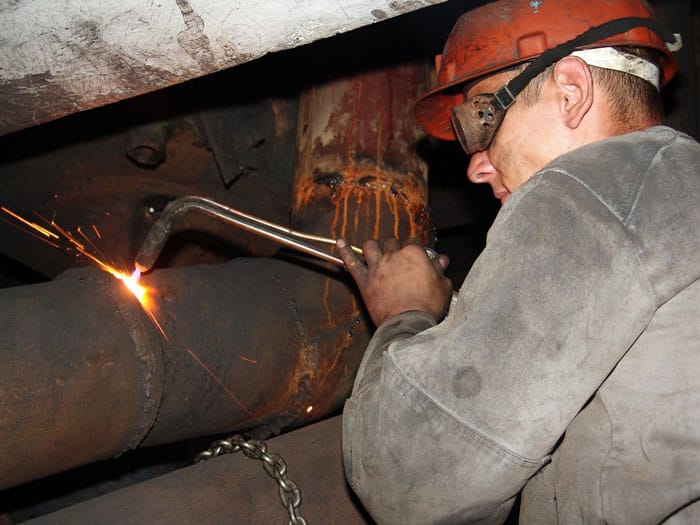
This post provides detailed information on the pipe welder job description, including key duties, tasks, and responsibilities they commonly perform.
(You will be able to download the pipe welder job description template in pdf below.)
It also highlights the major requirements that employers/recruiters usually expect candidates to meet to be hired for the pipe welder role.
What Does a Pipe Welder Do?
Pipe welders are welding professionals who employ various techniques to permanently join metal pipes together.
The pipe welder job description entails laying, fitting, and bonding pipes such as those found in automotive, plumbing, gas and other industrial applications.
In performing their duties, pipe welders read and interpret pipe construction schematic or blueprint in order to lay out a structure.
They prepare for a welding operation by cutting and shaping pipes using powersaws, grinders and other tools.
They also use calipers, straightedges, and other tools to align and secure metal parts.
The role of a pipe welder also involves conducting assessments to verify workpieces are free of defect and conform to set specifications.
They adhere to safety requirements by wearing appropriate protective gear during welding operations.
They also install and repair various types of pipes and tubular products according to set plans and building code.
As part of their responsibilities, welders monitor semi-automatic machines or robotic systems to adjust controls as necessary.
They determine the materials and position most suitable for a welding operation.
They also ensure pipe welding equipment are in good working order and serviced regularly.
Usually, pipe welders trim metal components using heat and electricity to remove excess material.
They monitor work environment to ensure healthy ventilation levels are maintained during welding to reduce the risk of gas inhalation.
They also develop and maintain working knowledge of various welding techniques and materials.
Pipe welder work description also entails marking or tagging workpieces with numbers, letters or other symbols for easy identification.
They connect and turn regulator valves to adjust gas pressure in order to obtain desired flame intensity.
They also clamp, heat-bend or grind pipe components to obtain suitable welding position.
Pipe welder description also involves selecting and installing filler rods, torches, and torch tips according to welding chart specifications and product type.
They monitor welding processes to avoid shrinking, expansion or distortion of workpieces.
They usually ignite torches by touching electrodes to metal being welded.
To get into the pipe welding career requires having minimum of high school diploma and undergoing some training as a pipe welding apprentice.
Some of the qualities and skills needed to excel on this job include problem-solving, technical, and communication skills.
Pipe Welder Job Description Example/Template
The job of a pipe welder entails various functions; given below is an example of job description that details the major duties, tasks, and responsibilities of the role:
- Assemble and install metal pipes and pipe fittings for stainless and carbon steel projects
- Use clamps, brackets, and hangers to secure pipes to structures
- Remove slags and rough spots from workpieces by operating grinders or scrapers to ensure smooth work surface
- Employ their knowledge of metallurgy to determine materials and equipment most suitable for a welding project
- Clean and prepare workpieces using chemical solutions etc. to remove foreign matter such as grease, rust etc.
- Use heating furnaces to preheat metal pipes prior to welding or bending
- Cut and shape metal components to set specifications using power saws, chipping knives or other hand tools
- Fill holes, cracks, and dents on metal workpieces or pipe products
- Use micrometers, calipers and other precision measuring instruments to check gap allowances, grooves or angles
- Assemble metal and non-metal pipes and pipe fitting using threading machine
- Study schematics, diagrams, and blueprints in order to determine the layout of pipes
- Measure and fabricate pipe routings to match existing in-line piping systems
- Control and turn valves or regulators to adjust flames and ensure proper use of welding gas
- Wear appropriate protective gear and ensure compliance with established health/safety regulations
- Troubleshoot a piping system and conduct diagnosis to identify and fix pipe problems.
Requirements – Skills, Abilities, and Knowledge – for Pipe Welder Job
If you are interested in working as a pipe welder, the following are major requirements that may qualify you to access the job with most employers:
- Education and Training: To become a pipe welder, you require minimum of a high school diploma or similar qualification. You are also required to complete a 3-5 year apprenticeship program with a Labor Union. As an added advantage, you can obtain certification from the American Welding Society (AWS) or other recognized body to demonstrate proficiency in specialized welding processes such as GTAW, FCAW etc.
- Problem-solving Skill: Pipe welders are given to conducting tests to identify and fix problems in a piping system
- Technical Skill: Pipe welders are able to operate hi-tech welding equipment and tools in carrying out welding operations
- Communication Skill: Pipe welders are able to comprehend safety rules, equipment instructions as well as producing detailed reports of work activities
- Pre-employment tests: To be accepted into an apprenticeship pipe welding program or offered a job after training, you may be required to take and pass a test. Learn about the assessment test you may need to take and how to come out tops.
Download pipe welder job description template (pdf).
Conclusion
If you are looking to hire a pipe welder, you can apply the sample job description given in this post, with some modifications to suit the peculiarity of your business operation, in designing one for your company.
You will be able to create a detailed work description that can help you find the best candidates for the job.
The information provided in this post about the duties and responsibilities of pipe welders is also useful to individuals interested in the career to learn about it and get prepared ahead.




